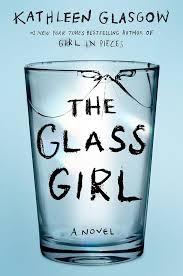Kathleen Glasgow is a young adult author who is known for writing books that are difficult to read, but absolutely necessary. Glasgow does not shy away from heavy topics and intense themes. Glashow’s book, Girl in Pieces, tells the story of a broken young girl struggling to put herself back together after a suicide attempt. Her book, How to Make Friends with the Dark, deals with death and grief after the main character loses her mother. Another one of her works, You’d be Home Now, handles the opioid crisis and the lives impacted by drug addiction.
Glasgow’s newest book, The Glass Girl, released on Oct. 1, features a teenage girl named Bella who is navigating the death of her beloved grandmother, the divorce of her parents and the heartbreak of her boyfriend ending their relationship. Bella is overwhelmed and underprepared for all of these changes. She drowns her sorrows in alcohol as a coping mechanism, but this turns into an addiction with devastating consequences.
Glasgow masterfully divides The Glass Girl into four parts. Part one of the book describes Bella’s background before she goes to rehab. Instantly, it is clear that Bella’s reliance on alcohol is unhealthy. Bella’s thoughts about her recent losses often consume her mind and overpower her thoughts. She discusses how the only way she is able to make it through each long day is knowing that at the end of it, she will forget about all of her problems when she gets to drink. This experience is highly relatable with not just alcoholism, but any self-destructive habit.
Her dependence on this substance reveals itself to be problematic in a number of ways. Her grades suffer in school when she misses assignments. Her health suffers as she feels sick from hangovers all of the time. Her friendships suffer as they cannot tolerate her emotional outbursts when she is drunk. However, more than anything, her self esteem suffers when she is forced to constantly confront the shame and humiliation of her drinking.
Glasgow does an excellent job painting the painful picture of how the cycle of self-destruction continues. Self-destructive behaviors are so addictive because they temporarily soothe internal turmoil. However, the sense of shame of these short-term gratifications comes back multiplied. In order to cope with the shame, addicts indulge in even more self-sabotage. A downward spiral continues until the addict eventually hits rock bottom.
Bella’s rock bottom is displayed in part two of The Glass Girl. It is brutally sad to read, but it is portrayed quite realistically. She goes to a party, drinks too much, publicly embarrasses herself and eventually blacks out. Her friends leave her outside of her mother’s house for dead, she is taken to the hospital for alcohol poisoning and she is forced to go to rehab.
Though it hurts to see Bella descend into such a low place, rock bottom is where a person stops digging. Bella’s journey towards recovery in parts three and four of the book is not perfect, but inspiring nonetheless. Glasgow has constructed such a complex, messy and beautiful character that readers cannot help but root for. All readers will be encouraged by this book to not necessarily avoid ever making mistakes, but to know that redemption is always possible.
You may also like
-
Lady Gaga’s “Mayhem” Fails to Disappoint
-
Crossroads Live Delivers a Phenomenal Production of Dear Evan Hansen in Columbus
-
UWG Theatre Breathes New Life into a Beloved Classic
-
QSA Annual Drag Show Entertains Eager, Diverse Crowd
-
Lucy Dacus’ Fourth Studio Album, Forever Is A Feeling, Encapsulates The Vulnerability and Thrill of Falling In Love
